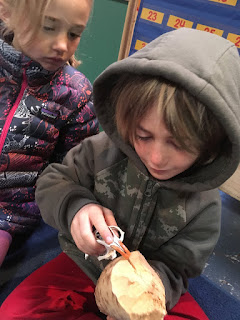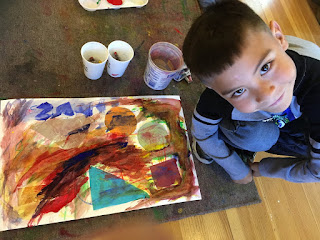

We will be celebrating Halloween in kinder on Monday. I ask that your child comes to school in regular clothing. The children will change into their costumes after lunch. There will be a costume parade and a class party starting at 1:30.
Please DO NOT SEND (or let your child bring/use) the following items: masks, weapons, blood, gory costuming, fangs (they come in and out of mouths and get passed around = unsanitary). Thank you for your support!
Boo! Not your grandma's beef stew!
Kinder is Making Witch's Brew on MONDAY!
Please bring the ingredient assigned for our "boil and bubble" Halloween! (What the ingredient stands for is a surprise! Shh! Don't tell!)
Annabella - Cheerios = cat eyes
Clover - Whipping cream = werewolf saliva
Gracen - 2 bottles of club soda = gargoyle sweat
Isaiah - Gummy Worms = earthworms
Miguel - Candy Corn = chicken toenails
Milo - Sunflower seeds = cat claws
Owen - red jello = vampire heart
Paris - Chocolate sprinkles = chopped bat whiskers
Santi - Bugles = witch fingers
Sebastian - Red Hots = blood drops
Tessa - kale chips = swamp weed
Tiana - chopped yellow onion = mummified toenails
Timothy - party prizes for 14 (stickers, tattoos, small party favors)
Winterfox - Pretzel sticks = bat bones
Jutka - marshmallows (skeleton teeth), M&Ms (zombie eyes), raisins (Dracula's buttons), fritos (bat wings), utensils, cups, plates, and cauldron + served on dry ice?
Halloween Parade and Party: 1:30-3:00
Please send costume with your child.
Please email/message me if you are interested in helping with the any of the following. If you are not avaiable on Monday, we'd love to have you ANY OTHER DAY between 2 and 3pm with one of the activities!
Monday between 2:00-3:30:
Candy graphing (I will provide graph and candy.)
Halloween write around the room (I will provide the activity. Your task is to set up and monitor.)
Halloween ring toss game (We have the game)
Face painting (I will provide paint)
Pumpkin/gourd activities such as counting, weighing, measuring (I have one pumpkin. We could use a couple more. Also a scale that's big enough for pumpkin weighing.)
Wax resist window art (Got paper and paint -- needed: small solid color candles from Cid's)
Maracas making (I have the decorations and rice/lentils to put in the shakers. You'd need to bring bottles/containers.)
Music (Halloween-themed karaoke)
Haunted Doll House
Ghost Frog Toss
Monday sometime before 2:00pm (the room needs to be ready by 2:00pm):
Party set-up/decorations (Halloween color balloons and paraphernalia)
Halloween riddles with prizes and scavenger hunt (hide prizes and bring riddles to solve before the party -- hide prizes around the playground for 14 children)
Room on the Broom Shadow puppet play (I need help setting up the shadow puppet screen. I have the puppets and the story)
I RECOMMEND CHARTING/STASHING/HIDING (or whatever else you might come up with) some of the candy and in bed by 8:00pm on MONDAY!
PLEASE MAKE SURE THAT YOUR CHILD DOES NOT BRING ANY CANDY OR SUGARY TREATS AFTER MONDAY!
Learning update:
Last week's letter: Aa
This week's letter: Gg
Encourage correct lowercase letter formation and using sounds for letters: a, b, c, g, m, p, t
Reading: "Tat the Rat" (see text attched)
Math: Adding within 10
Homework:
Reading response sheets (extra copies are in the tray by the homework basket)
Beginnig reading text to practice: Tat the rat (copy in same tray for you)
Number squeeze (You can use use a ruler or the number line from the learning resource packet you received at the open house. Please ask your child to teach you.)
Math book: page 11
Parent-teacher conferences:
Sign up online here or in class.
Lantern Walk Memories

Dripping color wax

Adding watercolor art











































